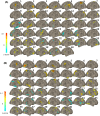Resting-state functional connectivity changes following audio-tactile speech training
- PMID: 40364857
- PMCID: PMC12069311
- DOI: 10.3389/fnins.2025.1482828
Resting-state functional connectivity changes following audio-tactile speech training
Abstract
Understanding speech in background noise is a challenging task, especially when the signal is also distorted. In a series of previous studies, we have shown that comprehension can improve if, simultaneously with auditory speech, the person receives speech-extracted low-frequency signals on their fingertips. The effect increases after short audio-tactile speech training. In this study, we used resting-state functional magnetic resonance imaging (rsfMRI) to measure spontaneous low-frequency oscillations in the brain while at rest to assess training-induced changes in functional connectivity. We observed enhanced functional connectivity (FC) within a right-hemisphere cluster corresponding to the middle temporal motion area (MT), the extrastriate body area (EBA), and the lateral occipital cortex (LOC), which, before the training, was found to be more connected to the bilateral dorsal anterior insula. Furthermore, early visual areas demonstrated a switch from increased connectivity with the auditory cortex before training to increased connectivity with a sensory/multisensory association parietal hub, contralateral to the palm receiving vibrotactile inputs, after training. In addition, the right sensorimotor cortex, including finger representations, was more connected internally after the training. The results altogether can be interpreted within two main complementary frameworks. The first, speech-specific, factor relates to the pre-existing brain connectivity for audio-visual speech processing, including early visual, motion, and body regions involved in lip-reading and gesture analysis under difficult acoustic conditions, upon which the new audio-tactile speech network might be built. The other framework refers to spatial/body awareness and audio-tactile integration, both of which are necessary for performing the task, including in the revealed parietal and insular regions. It is possible that an extended training period is necessary to directly strengthen functional connections between the auditory and the sensorimotor brain regions for the utterly novel multisensory task. The results contribute to a better understanding of the largely unknown neuronal mechanisms underlying tactile speech benefits for speech comprehension and may be relevant for rehabilitation in the hearing-impaired population.
Keywords: cochlear implants; fMRI; multisensory training; resting-state functional MRI; speech comprehension; tactile aid.
Copyright © 2025 Cieśla, Wolak and Amedi.
Conflict of interest statement
The authors declare that the research was conducted in the absence of any commercial or financial relationships that could be construed as a potential conflict of interest.
Figures



Similar articles
-
Effects of training and using an audio-tactile sensory substitution device on speech-in-noise understanding.Sci Rep. 2022 Feb 25;12(1):3206. doi: 10.1038/s41598-022-06855-8. Sci Rep. 2022. PMID: 35217676 Free PMC article.
-
The connectivity signature of co-speech gesture integration: The superior temporal sulcus modulates connectivity between areas related to visual gesture and auditory speech processing.Neuroimage. 2018 Nov 1;181:539-549. doi: 10.1016/j.neuroimage.2018.07.037. Epub 2018 Jul 17. Neuroimage. 2018. PMID: 30025854
-
Immediate improvement of speech-in-noise perception through multisensory stimulation via an auditory to tactile sensory substitution.Restor Neurol Neurosci. 2019;37(2):155-166. doi: 10.3233/RNN-190898. Restor Neurol Neurosci. 2019. PMID: 31006700 Free PMC article.
-
Combined diffusion-weighted and functional magnetic resonance imaging reveals a temporal-occipital network involved in auditory-visual object processing.Front Integr Neurosci. 2013 Feb 13;7:5. doi: 10.3389/fnint.2013.00005. eCollection 2013. Front Integr Neurosci. 2013. PMID: 23407860 Free PMC article.
-
Altered Functional Connectivity in Patients With Sloping Sensorineural Hearing Loss.Front Hum Neurosci. 2019 Aug 22;13:284. doi: 10.3389/fnhum.2019.00284. eCollection 2019. Front Hum Neurosci. 2019. PMID: 31507391 Free PMC article.
References
-
- Ardilla A., Bernal B., Rosselli M. (2014). Participation of the insula in language revisited: a meta-analytic connectivity study. J. Neurolinguistics 29, 31–41. 10.1016/j.jneuroling.2014.02.001 - DOI
-
- Augustine G. J. (eds.). (2023). Neuroscience (Oxford: Sinauer Associates, Oxford University Press; 7th edition; ).
LinkOut - more resources
Full Text Sources

